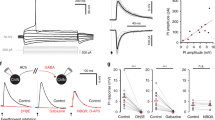Abstract
THE slow excitatory postsynaptic potential (slow EPSP) of vertebrate sympathetic ganglia is elicited by the muscarinic action of acetylcholine1,2. Its electrogenic mechanism appears strikingly different from that of the well-known (fast) EPSP in many respects—most notably that it is generated with no detectable increase in membrane conductance3. As this type of transmitter action is probably related to cholinergic processes in the brain4,5 and possibly in the spinal cord6, further study of the slow EPSP in the ganglia as a simpler model of the central cholinergic pathways is of great significance.
This is a preview of subscription content, access via your institution
Access options
Subscribe to this journal
Receive 51 print issues and online access
$199.00 per year
only $3.90 per issue
Buy this article
- Purchase on Springer Link
- Instant access to full article PDF
Prices may be subject to local taxes which are calculated during checkout
Similar content being viewed by others
References
Libet, B. Fedn Proc. 29, 1945–1956 (1970).
Kobayashi, H., Hashiguchi, T. & Ushiyama, N. S. Nature 271, 268–270 (1978).
Kobayashi, H. & Libet, B. Proc. natn. Acad. Sci. U.S.A. 60, 1304–1311 (1968); J. Physiol., Lond. 208, 353–372 (1970).
Krnjevic, K. Fedn Proc. 28, 113–120 (1969).
Krnjevic, K., Pumain, R. & Renaud, L. J. Physiol., Lond. 215, 247–268 (1971).
Krnjevic, K., Puil, E. & Werman, R., Can. J. Physiol. Pharmacol. 54, 172–176 (1976).
Greengard, P. Nature 260, 101–108 (1976).
McAfee, D. & Greengard, P. Science 178, 310–312 (1972).
Woody, C. D., Anchors, J. M., Gruen, E. & Swartz, B. Fedn Proc. 35, 2401 (1976).
Swartz, B. & Woody, C. D. Neurosci. Abstr. 2, 1156 (1976).
Shinnick-Gallagher, P., Williams, B. J. & Gallagher, J. P. Neurosci. Abstr. 2, 1152 (1976).
Hsu, S. Y. Fedn Proc. 36, 319 (1977).
Weight, F. F. & Votava, J. Science 170, 755–757 (1970).
Nishi, S., Soeda, H. & Koketsu, K. Life Sci. 8 (Part 1), 33–42 (1969).
Hille, B. J. gen. Physiol. 50, 1287–1302 (1967).
Kebabian, J. W., Steiner, A. L. & Greengard, P. J. Pharmac. exp. Ther. 193, 474–488 (1975).
Weight, F. F., Petzold, G. & Greengard, P. Science 186, 942–944 (1974).
Blackman, J. G. & Purves, R. D. J. Physiol., Lond. 203, 173–198 (1969).
Author information
Authors and Affiliations
Rights and permissions
About this article
Cite this article
HASHIGUCHI, T., USHIYAMA, N., KOBAYASHI, H. et al. Does cyclic GMP mediate the slow excitatory synaptic potential in sympathetic ganglia?. Nature 271, 267–268 (1978). https://doi.org/10.1038/271267a0
Received:
Accepted:
Published:
Issue Date:
DOI: https://doi.org/10.1038/271267a0
This article is cited by
-
Cyclic nucleotides may mediate taste transduction
Nature (1988)
-
Mediation of slow-inhibitory postsynaptic potentials
Nature (1985)
-
Mechanisms of slow postsynaptic potentials
Nature (1981)
Comments
By submitting a comment you agree to abide by our Terms and Community Guidelines. If you find something abusive or that does not comply with our terms or guidelines please flag it as inappropriate.



